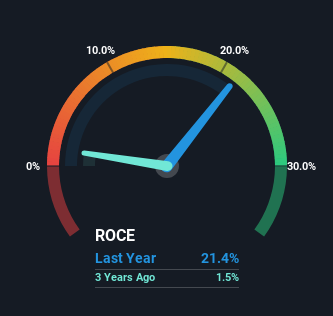- India
- /
- Commercial Services
- /
- NSEI:LINC
The Trend Of High Returns At Linc (NSE:LINC) Has Us Very Interested
If we want to find a stock that could multiply over the long term, what are the underlying trends we should look for? Firstly, we'd want to identify a growing return on capital employed (ROCE) and then alongside that, an ever-increasing base of capital employed. Basically this means that a company has profitable initiatives that it can continue to reinvest in, which is a trait of a compounding machine. Speaking of which, we noticed some great changes in Linc's (NSE:LINC) returns on capital, so let's have a look.
Return On Capital Employed (ROCE): What Is It?
Just to clarify if you're unsure, ROCE is a metric for evaluating how much pre-tax income (in percentage terms) a company earns on the capital invested in its business. Analysts use this formula to calculate it for Linc:
Return on Capital Employed = Earnings Before Interest and Tax (EBIT) ÷ (Total Assets - Current Liabilities)
0.21 = ₹447m ÷ (₹2.6b - ₹532m) (Based on the trailing twelve months to December 2023).
Therefore, Linc has an ROCE of 21%. In absolute terms that's a very respectable return and compared to the Commercial Services industry average of 18% it's pretty much on par.
View our latest analysis for Linc

Historical performance is a great place to start when researching a stock so above you can see the gauge for Linc's ROCE against it's prior returns. If you're interested in investigating Linc's past further, check out this free graph covering Linc's past earnings, revenue and cash flow.
What The Trend Of ROCE Can Tell Us
Investors would be pleased with what's happening at Linc. Over the last five years, returns on capital employed have risen substantially to 21%. The company is effectively making more money per dollar of capital used, and it's worth noting that the amount of capital has increased too, by 48%. The increasing returns on a growing amount of capital is common amongst multi-baggers and that's why we're impressed.
On a related note, the company's ratio of current liabilities to total assets has decreased to 20%, which basically reduces it's funding from the likes of short-term creditors or suppliers. So shareholders would be pleased that the growth in returns has mostly come from underlying business performance.
In Conclusion...
To sum it up, Linc has proven it can reinvest in the business and generate higher returns on that capital employed, which is terrific. And with the stock having performed exceptionally well over the last five years, these patterns are being accounted for by investors. In light of that, we think it's worth looking further into this stock because if Linc can keep these trends up, it could have a bright future ahead.
One more thing to note, we've identified 2 warning signs with Linc and understanding them should be part of your investment process.
High returns are a key ingredient to strong performance, so check out our free list ofstocks earning high returns on equity with solid balance sheets.
New: AI Stock Screener & Alerts
Our new AI Stock Screener scans the market every day to uncover opportunities.
• Dividend Powerhouses (3%+ Yield)
• Undervalued Small Caps with Insider Buying
• High growth Tech and AI Companies
Or build your own from over 50 metrics.
Have feedback on this article? Concerned about the content? Get in touch with us directly. Alternatively, email editorial-team (at) simplywallst.com.
This article by Simply Wall St is general in nature. We provide commentary based on historical data and analyst forecasts only using an unbiased methodology and our articles are not intended to be financial advice. It does not constitute a recommendation to buy or sell any stock, and does not take account of your objectives, or your financial situation. We aim to bring you long-term focused analysis driven by fundamental data. Note that our analysis may not factor in the latest price-sensitive company announcements or qualitative material. Simply Wall St has no position in any stocks mentioned.
About NSEI:LINC
Linc
Manufactures and sells writing instruments and stationeries in India and internationally.
Flawless balance sheet average dividend payer.
Similar Companies
Market Insights
Community Narratives




